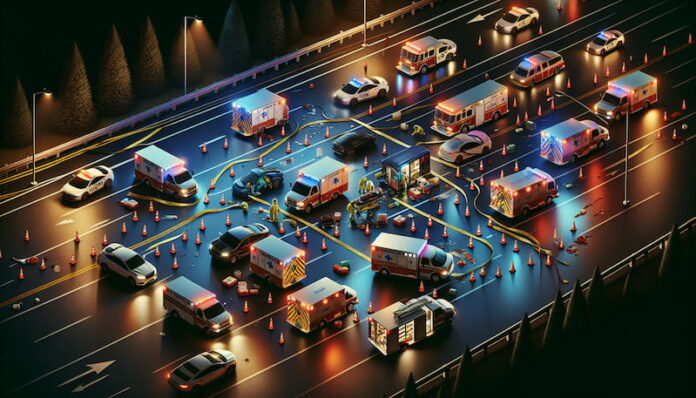Road accidents are events that bring immediate chaos and confusion. In these moments, emergency response teams become the backbone of crisis management showcasing swift action and thorough coordination. Their mission is crucial for saving lives. The assigned team reduces the impact of the incident and supports the emergency management operation, while simultaneously ensuring that bystanders and anyone else involved is cared for and safe.
Immediate Action After an Accident
An alert about an accident triggers the response team into motion. They gather vital details—where the incident happened, the severity and potential injuries. Armed with essential equipment, the team heads out, the urgency of their mission clear. Navigating traffic and coordinating with other emergency services are key. Their preparedness and rapid response are foundational in a successful rescue effort.
The team’s quick response is not just about speed, but also about bringing the right resources to the scene. They come prepared with medical equipment, rescue tools and communication devices. This preparation allows them to handle a wide range of situations effectively, from providing basic medical care to extricating victims trapped in vehicles. Their readiness is a testament to the extensive training and planning that goes into emergency response.
On-Scene Assessment and Emergency Care
Upon reaching the scene, securing the area and evaluating the situation are the team’s first steps. The first on site are usually composed paramedics and heroic firefighters, who are absolutely essential as they quickly determine the victims’ conditions, deciding who needs immediate attention. They provide critical first aid and other interventions right there, bringing not just medical help but also comfort to those involved.
The team’s assessment also involves ensuring the safety of everyone at the scene, including bystanders and other emergency personnel. They set up a perimeter, direct traffic away from the area, and mitigate any potential hazards such as fuel spills or unstable vehicles. By creating a safe working environment, they can focus on providing the best possible care to the victims without additional risks.
Linking with Healthcare Facilities
Choosing the right healthcare facility for the victims involves careful consideration of their needs and the hospital capacities. Efficient coordination ensures the victims continue to receive essential care upon arrival. The information the team collects and shares during transport is critical for a smooth handover to hospital staff.
The team’s role in linking and connecting with healthcare facilities extends beyond just transportation. They often stay in touch with the hospital staff to provide updates on the victim’s condition and estimated arrival time. This continuous communication helps the hospital prepare for the patient’s arrival, ensuring that the necessary resources and specialists are ready. This seamless transition of care is crucial for maximizing the chances of a successful recovery.
Reflecting and Preparing for the Future
After the operation, reflection is crucial. The team assesses their performance, celebrates successes and identifies areas for improvement. They also focus on community engagement, educating the public on safety to help prevent future accidents. This proactive approach is vital for enhancing responses to future emergencies.
In essence, the emergency response team’s role in road accidents is immensely vital. From the initial dispatch to the transfer of victims to medical facilities and beyond, their actions are geared towards preserving life and minimizing the accident’s aftermath. Their efficient and coordinated efforts not only speak to the core of emergency management, but also highlight the critical partnership between emergency and medical services. Together, they work towards a safer, more responsive community.
Reflection also involves taking care of the team’s own mental and emotional well-being. Responding to road accidents can be traumatic, and it’s essential for team members to have access to support services and debriefing sessions. By prioritizing their own health, they can continue to serve the community effectively in the long term. This holistic approach to emergency response recognizes the human element behind the uniforms and sirens.
Did you find this helpful? Check out our other helpful articles on our website.
Read Also
- Ketamine-Assisted Therapies: Impacts on Employee WellbeingWorkplace stress is common today. Many employees feel tired, anxious, or burned out. Regular therapy can help, but some people need more support. Ketamine-assisted therapy is showing good results for mental health. A ketamine-assisted therapist guides each session safely. This therapy can improve mood, focus, and energy. Learning more about it can help teams stay… Read more: Ketamine-Assisted Therapies: Impacts on Employee Wellbeing
- The Future of Men’s Health: Why Telehealth Is Here to StayTelehealth isn’t just a pandemic trend that faded into the background. For Australian men, it has become one of the most practical, time-saving, and stress-free ways to manage everyday health — and it’s shaping the future of how we access care. Platforms like DOCTO, an Australian online doctor and specialist telehealth service, are leading the… Read more: The Future of Men’s Health: Why Telehealth Is Here to Stay
- How to Build a Simple, Clean Skincare Routine ?You don’t need a complicated skincare routine. It doesn’t have to be something that requires twenty different products and confusing steps. Your routine works well with just a few high-quality clean ingredients. The beauty industry keeps pushing more products, but your skin actually needs less. You only need a simple approach to get better results… Read more: How to Build a Simple, Clean Skincare Routine ?
- How Preventive Dental Care Supports Overall HealthHave you ever wondered how a simple dental checkup could impact your entire body? Oral health is more than just a bright smile. Studies show that poor dental habits can contribute to serious health problems. Gum disease and tooth decay are linked to heart disease, diabetes, and infections. Yet, many people overlook preventive dental care.… Read more: How Preventive Dental Care Supports Overall Health
- Seeing Clearly in a High-Tech World: A Deep Dive into Advanced Vision Care ServicesProtecting your eyesight isn’t optional—it’s essential. Modern eye care has evolved far beyond basic exams, offering advanced diagnostics, personalized treatments, and surgical innovations that keep vision sharp for life. A leading example is Intermountain Eye Center, home to specialists like Dr Fishburn Boise, where patients receive comprehensive, high-level vision care designed to preserve long-term eye… Read more: Seeing Clearly in a High-Tech World: A Deep Dive into Advanced Vision Care Services
- Why the Keto Diet Works for Some People—and Fails Dramatically for Others: An Ayurvedic Breakdown for Modern HealthcareThe keto diet has dominated weight-loss culture for years. For some people, it produces rapid fat loss, stable energy, and improved mental clarity. For others—especially those who gain weight easily—it leads to burnout, digestive distress, rebound weight gain, high cholesterol, and a metabolism that feels slower than before. Healthcare often frames this as a discipline… Read more: Why the Keto Diet Works for Some People—and Fails Dramatically for Others: An Ayurvedic Breakdown for Modern Healthcare
- How to Choose the Best Assisted Living Facility for SeniorsAre you looking for the right assisted living facility for a senior loved one? Choosing a place can feel overwhelming. There are many factors to consider, from care services to the environment. Safety, comfort, and social opportunities play important roles in daily life. Each senior has unique needs and preferences that must be met. Understanding… Read more: How to Choose the Best Assisted Living Facility for Seniors
- Burn Smart, Not Hard; Shape Burn: Clean Protein for Weight ManagementYou want to feel light, strong, and confident. You don’t want crash diets or fake promises. You need a plan that works with your body, not against it. That’s where Shape Burn comes in. You can burn fat without losing strength. You can eat better and stay full. You can manage weight in a way… Read more: Burn Smart, Not Hard; Shape Burn: Clean Protein for Weight Management









